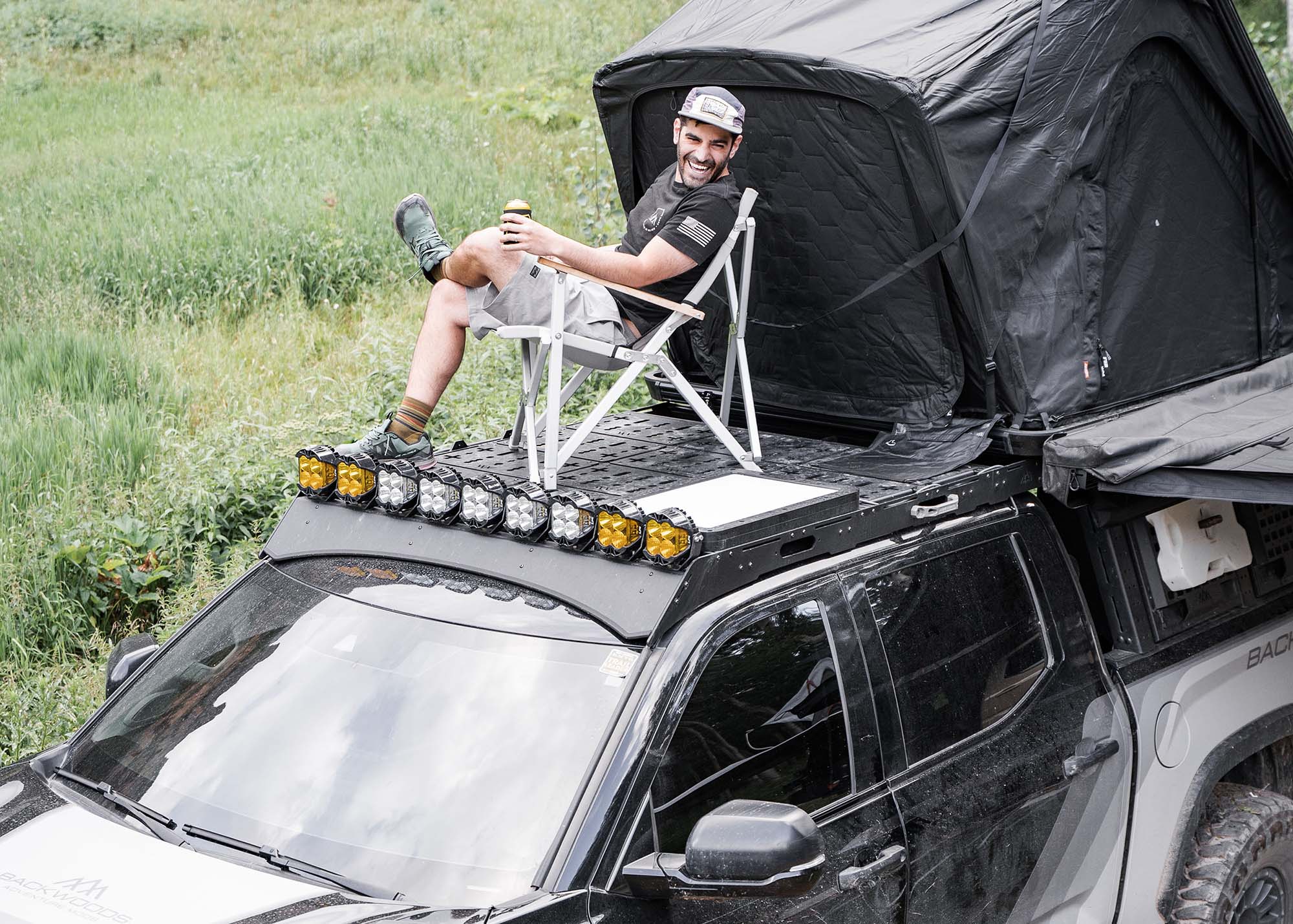If you’re an outdoor enthusiast who loves packing gear for adventures, you’ve likely heard about static and dynamic loads. But what do these terms really mean for roof racks and truck bed racks? Here’s a quick, easy-to-understand guide that spells out the difference and helps you keep your gear secure, handling predictable, and improve safety on the trail or the highway.
What is Static Load?
Static load is the weight that a rack or mounting system can carry when everything is still. Imagine you’ve parked your SUV or pickup, the engine is off, the wind is calm, and you’re loading a cooler, a bike, or a rooftop tent. The static load rating on your rack tells you the maximum weight that can sit on top without causing deformation, mounting fatigue, or failure, when there’s no extra movement or jolting.
Key points about static loads:
-
It covers the weight of the cargo plus the weight of the rack itself, spread out over the crossbars or mounting points.
-
It’s essentially the “no movement” stress test: the forces are predictable, gravity-only, with no acceleration, braking, or road-induced jostling.
-
Exceeding the static load rating can bend crossbars, loosen clamps, or strain anchor points, especially over long trips.
What is Dynamic Load?
Dynamic load accounts for motion and the extra forces that show up when your vehicle is on the move. This includes acceleration, braking, cornering, hitting rocks or speed bumps, driving over washboards, and even gusts of wind pressing on your cargo. Dynamic loads can push a rack well beyond its static rating because forces are amplified by speed, vehicle motion, and road conditions.
A few real-world examples of dynamic load:
-
A quick stop or rapid acceleration adds inertia that tries to fling or shift your cargo.
-
Hitting a pothole or patch of rough road sends shock waves through the rack and mounting hardware.
-
Strong crosswinds or passing semi-trucks create gusts that lift or shift items on exposed racks.
-
Off-camber trail sections when driving off road can cause lateral movement, sway, and twisting on roof or bed racks.
The takeaway: dynamic load is any extra “stress” that happens because the vehicle is moving and interacting with the environment. It’s not a single number on a spec sheet, but a set of scenarios engineers attempt to consider to ensure the rack system stays secure under real-world driving conditions.
Understand Your Vehicle’s Roof and Bed Rail Load Capacity Ratings

Dynamic Load Capacity Ratings
Your vehicle’s roof or bed rail dynamic load capacity indicates how much weight they can carry while in motion, also referred to as the roof or bed rail’s dynamic weight capacity (DWC). Vehicle manufacturers determine this number and include it in your vehicle manual so that you know how much weight you can load onto your vehicle’s roof or bed rails without compromising safety. The roof and bed rail’s DWC will always be lower than their static weight capacity (SWC) because SWC doesn’t need to account for the shifting weight and other dynamic effects that happen when the vehicle is in motion.
Static Load Capacity Ratings
A vehicle’s static roof or bed rail load capacity, a.k.a. static weight capacity, indicates how much your vehicle’s roof or bed rails can carry while stationary. The roof or bed rail’s SWC are typically three to six times higher than their dynamic weight capacity. This means you can place more weight on the roof or bed rails while the vehicle is parked.
Why is this important? Well, if you have a roof top tent that uses up all of your vehicle roof or bed rail’s DWC, you can still sleep in your tent with your gear when you’re parked without worry as long as the combined weight doesn’t exceed the SWC. Similarly, if you’d rather store some heavier gear on top of your rig while camping to make more interior room in the cab or truck bed for sleeping, you can - just be sure that when you hit the road or trail again, the weight of the items on your roof falls within the DWC.
Here at Backwoods Adventure Mods we always supply both static and dynamic load ratings for our roof racks and truck bed racks, and our racks are typically built to far exceed the vehicle manufacturers’ SWC and DWC ratings; so you don’t have to guess where the cargo capacity bottleneck is when you’re packing for your next adventure.
How Static and Dynamic Loads Apply to Racks
Roof Racks Load Effects
-
Exposure to wind - the roof is a big, exposed surface. Heavy cargo on the roof increases wind pressure, which adds dynamic uplift and drag forces, especially at highway speeds.
-
Center of gravity matters - weight high on the vehicle top raises the center of gravity, affecting handling when you lean into curves or swerve to avoid obstacles.
- Attachment points - roof racks rely on clamps or mounts securing to roof rails, gutters, or sometimes directly to the vehicle roof. If any mounting is loose, dynamic loads can pry components away or cause cargo to shift.
Pro Tip: respect the static load rating, but also anticipate dynamic factors. Keep loads lower and closer to the centerline of the vehicle when possible, distribute weight evenly, and use high-quality tie-downs designed for outdoor gear.
Truck Bed Rack Load Effects
- Wind load - like roof racks wind is still a factor, but the exposure is different. Depending on bed height and rack design (full-height vs mid-height), cargo may be exposed to various degrees of wind but generally not as directly as on the roof.
-
Movement within the bed matters - cargo can shift during off-road travel or heavy braking, creating internal dynamic loads. Proper tie-down angles, using multiple straps, and secure anchor points are vital.
- Mounting options - bed racks often bolt or clamp to your truck’s bed rails or factory rail system. A solid, well-secured mounting system helps resist dynamic forces from rough roads or jumps (if you happen to accidentally yeet your rig with a little too much skinny peddle 😅).
Pro Tip: respect static ratings, but plan for dynamic loads by using redundant tie-downs, keeping heavier items close to the truck bed’s floor, and ensuring that load distribution doesn’t pull on one mounting point too hard.
How to Stay Safe and Make Sure Your Gear is Secure

- Know the ratings and don’t exceed them
Static load ratings tell you the maximum weight under still conditions; be aware that not all racks have explicit dynamic load ratings. If your gear-loaded scenario includes fast driving or rough terrain, err on the side of a lower load than the static rating and consider a dynamic safety factor. - Add a dynamic safety factor
Many outdoor enthusiasts - including us here at Backwoods Adventure Mods - apply a practical cushion (for example, 15-25% of static rating) to account for motion, wind, and road conditions. If you regularly drive off road or in windy areas, consider a larger cushion. - Distribute weight evenly
Place heavier items toward the center and as low as possible. On roof racks, avoid stacking tall items that catch wind; on bed racks, stack evenly along the length to minimize leverage on any single mounting point. - Use proper tie-downs and check them often
High-quality ratchet straps or cam-buckle straps with non-scratch protectors help. Double-check knots, strap tension, and anchor points before every trip, and stop mid-trip to recheck after long stretches or rough sections. - Secure ALL pieces of cargo
Ensure that every wheel, kayak, bike, cooler, or tent component is firmly fastened and cannot shift during acceleration, braking, or cornering. Loose items become dynamic hazards! - Inspect mounting hardware
Regularly checking for corrosion, wear, loosening bolts, or damaged clamps go a long way toward preventing dynamic failures of your vehicle’s rack systems on the road. - Remember to consider aerodynamics
Bulky, irregularly shaped cargo raises dynamic drag and uplift. If possible, use streamlined or well-secured gear to reduce wind-related forces.
Some Practical Tips for Common Setups
Roof Racks:
- Use crossbars made for your vehicle, and that offer a wide variety of attachment/securement options (like our DRIFTR racks!)
- Keep the weight exceptions small (caution with heavy items like large water canteens or big coolers that slosh, creating increased dynamic loads).
- When loading, place the heaviest items as low as possible and toward the center to minimize tipping risks.
- If you’re on fast highways or windy routes, reduce load weight slightly and use additional tie-downs at multiple points.
Truck Bed Racks:
- Secure gear with multiple tie-downs along the length of the bed rack, not just at the ends
- Use bed rail mounts that distribute force and avoid mounting only at one corner.
- If hauling loose items, consider a heavy-duty cargo net or a soft tonneau cover to keep things in place during bumps…or jumps 🙃.
Common Mistakes to Avoid
-
Overloading, up to or beyond the static ratings, in hopes dynamic forces won’t matter.
-
Skimping on securing all points, or using low-quality straps that can stretch or break under load.
-
Placing heavy gear on top of tall or oddly shaped items that catch wind and create unpredictable dynamic loads.
- Improper rack installation: follow the install directions to a tee!
- Ignoring maintenance: rusted clamps, loose bolts, or worn straps can fail when dynamic forces rise. (Tip: a small dab of blue Loctite 242 Threadlocker on fasteners during assembly can go a long way to preventing loosening from the vibration - still, always double check your rack fasteners as part of routine maintenance)
Final Checklist Before You Hit the Road or Trail
-
Check static load rating and apply a dynamic safety factor appropriate for your route.
-
Distribute weight evenly; keep the load centered and low where possible.
-
Use multiple, high-quality tie-downs or straps with proper tension.
-
Inspect mounts, straps, and cargo before departure and during long trips or rough trail sections.
-
Adjust your driving for the load: slower speeds on rough or off-camber roads, gentler turns, and more frequent checks in windy conditions.
If you’re curious about the exact numbers for your gear and vehicle, consult the vehicle and rack manufacturer’s specifications. They’ll give you the official static load rating, any available dynamic load guidance, and recommended installation practices tailored to your roof rack or truck bed rack setup.
With a little forethought and planning, you can maximize the utility of your roof rack or bed rack while keeping yourself and your gear safe through every overland adventure, windy highway stretch, or weekend off-roading trip.
If you ever have any questions about your Backwoods Adventure Mods roof racks or bed racks, just contact us - we want you to spend less time worrying about your gear, and more time using it!

